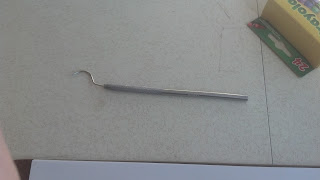 |
| Marceline doesn't count. She's the Vampire Queen. She can't even go into the sun. |
 |
| Technically, this is a soldering probe, but any stabby pointy thing will work. A needle is just fine. |
Yep, that's a toilet paper tube with some aluminum foil wrapped around one side, and the tiny hole punched into the foil. I know it looks pretty crappy, but it works perfectly well at projecting images of the sun:
See? This image helps illustrate two points: First, if you're trying to align the eclipse viewer to see the Sun's image, you just have to minimize the shadow you're making with the object. As you wiggle it around, the shadow grows when it's "off axis," and is smallest when it's "on axis." Simple. Secondly, if you zoom in on that image, you'll notice that the image is distorted because the paper I'm projecting it on isn't parallel to the foil sheet.
This leads to the next design, which I personally like the best:
An empty Puffs kleenex box (we're not having that argument again). Puffs is nice because it has that big opening, making it easy to view the image. Stabby stabby:
 |
| There are two holes there, it might be hard to see them. |
Zooming in, we can see an interesting feature from the two holes:
If you clicked to get a close-up of the holes on the outside, you'll note that one of the holes is smaller than the other. However, this photo shows that the images created by both holes are the same size. This is an indication that we're actually making a pinhole camera (see below), and not just seeing the circle of the hole. If that were the case, and we were just seeing the light coming through the hole straight, then the small hole would make a small image. It doesn't, although you can see that it's much fainter. Since less light can go through the small hole, it's not as bright as the big hole.
Ok, final eclipse viewer design: bookshelf box I should have thrown out a year ago version:
Stabby stabby:
This one has the same basic design as the toilet paper tube version. Light comes in the one end, you minimize the size of the shadow, and project the image on a surface:
My surface was obviously at an angle again, but that's ok.
It's probably hard to tell from the different images, but the size of the image changes with each of these designs. The farther the projection screen is from the pinhole, the larger the image it forms.
Although the eclipse isn't going to be that spectacular here in Hawaii, there is a transit of Venus coming up next month, and Hawaii is right in the middle of the viewing region. I caught the previous one eight years ago, which was visible in Michigan (we went and had IHOP for breakfast afterwards). However, if you miss this one, you're going to have to wait like 105 years (seriously). In any case, it might be a bit hard to see with this kind of eclipse viewer since Venus is so small relative to the Sun, but it should be possible. I'll probably need to brace the viewer a bit, and make sure the screen is nice and white.
Ok, optics time:
All of these designs is a form of a pinhole camera, in which a tiny hole creates an image on the other side. It's kind of hard to see in the crayon theater drawing, but the sun image on the right shines down, and if it wants to get through the hole, it has to be going at just the right angle to sneak through. This means that the top of the Sun has to angle down a bit, and the bottom up a bit. Since light goes in a straight line, the image it forms has the top and bottom reversed. The same thing happens to the left and right, as they're flipped around too.
One other interesting thing about pinhole cameras: Remember those episodes of Scooby Doo where they had the paintings with the eyes that followed the gang around?
 |
| Like this, although I can't tell if this exact one had the eyes. You know what I'm talking about, though. |
If the bad guys had just poked tiny pinholes through the painting, then, as long as the room the gang was in was well lit, they could just look at the image that the pinhole projected on the opposite wall. That would definitely be less obvious than paintings with real eyes.
Here's another example of a pinhole camera on a much larger and impressive scale.









No comments:
Post a Comment